Customer-Content Fit and Journey-Offer Fit Workshops: Examples of What It’s like to Work with Powered by Search
Last updated: December 9th, 2019

If you’re going to allocate serious budget to an agency to handle your digital marketing, you should have a clear idea of what it would actually be like to work with them.
This is one of the primary functions of our SaaS Marketing Blog — to document our approach and provide you with a detailed picture of what it looks and feels like to work with us. We strive to be as transparent as possible because we want our clients to know exactly what they’re signing up for.
Plenty of agencies are happy to provide you with a questionnaire, log in to your accounts and start doing the work. To us, that’s not good enough. No one knows your company better than you do, so we take a highly collaborative approach to working with our clients.
To give you an idea of what we mean, we wanted to share some examples of the types of workshops we’ve done with clients in the past:
- Example #1: Brainstorming Ways to Improve Home Page Copy
- Example #2: Applying Landing Page Practices to BoardOnTrack’s Home Page
- Example #3: Building a Self-Assessment Lead Magnet
- Example #4: Building a Customer Pain Point Lead Magnet for Restaurant Systems Pro
These are what we’ll be discussing in today’s article.
Each of the workshop examples we cover are from our SaaS Pilot Program (explained below). If you are interested in learning more about the program or think you would be a good fit, you can schedule a Free SaaS Scale Session to learn more about opportunities for working together.
Our SaaS Pilot Program, Explained
The SaaS Pilot Program is a 90-day process where we develop, test, and refine three fundamental elements of your digital marketing:
- Customer-Channel Fit: Test ads on LinkedIn, Google, and Facebook to help you discover the best channels to reach new customers.
- Customer-Content Fit: Start to refine the content of your website so that it communicates your positioning clearly and reduces friction on the path to book a demo.
- Journey-Offer Fit: Match what you offer customers to their current place in the sales funnel.
In essence, we work to fine-tune how your SaaS company attracts prospects who are the right fit and how you turn them into customers. Alongside this process, we establish benchmark demo or trial acquisition metrics that (this is part is key) can be tied to actual revenue:
- The cost per demo or trial by channel.
- The conversion rates on the path from ad click to a demo or trial signup.
Throughout the program, we facilitate two workshops, one on Customer-Content Fit and one on Journey-Offer Fit. Before we get to specific examples of the types of exercises we do, here is a quick overview of how these workshops are done in practice.
What to Expect in Our Workshops
Overview
- Duration: 90 minutes per workshop
- Medium: We typically run workshops virtually using Zoom (sessions are recorded)
- Facilitator: One facilitator from Powered By Search guides the session
- Note-taker: One individual from your team is appointed as the note-taker
- Group Size: Typically 8-10 people representing different areas of your organization (leadership, marketing, sales, product)
Expectations
First and foremost, we establish an atmosphere where there are no right or wrong answers. We want everyone to feel comfortable and welcome so that participation is encouraged and evenly distributed amongst the group.
By hearing from the different stakeholders in the room, we’re able to discover where there are differing viewpoints and work towards finding alignment on the topics we cover.
We’re often especially interested in what quieter team members have to say, and every person in the session can expect to be polled throughout. After each section we’ll ask questions like:
- What’s been most valuable for you so far?
- What do you think has been the most impactful?
- What are you going to change based on what we’ve discussed?
These function as consensus-building questions to continually check in and make sure everyone is on the same page.
Goals
There are three primary goals of our workshops:
- To help your team find alignment and clarity on your positioning (informed by perspectives from across your organization).
- To provide you with specific, actionable recommendations on how to improve your website’s structure and content so it reflects your positioning.
- To co-create a new lead magnet for educating and motivating prospects who are higher in the funnel.
Now let’s look at some details of our workshop on customer-content fit.
Customer-Content Fit Workshop: Analyzing Copy and Structure
In our first 90 minute workshop, we walk through your entire website together to try to understand what your site looks like through your customer’s eyes.
We’re seeking to identify any bottlenecks on your site that prevent prospects from taking one of the key actions you hope they’ll take when they visit.
The two main bottlenecks we work on addressing are the copy and structure of your content. Let’s talk about copy first.
Copywriting: Communicating Clearly to Prospects
Bottlenecks typically start with the words on your site.
Very often our clients will have a good understanding of their customers and their pain points, but their website copy won’t reflect their understanding as well as it should.
And when your messaging doesn’t communicate the positioning of who you are and how your product works to solve a real pain point for your customers, bounce rates will be high and your site will underperform.
So this is usually where we begin.
Workshop Example #1: Brainstorming Ways to Improve Home Page Copy
Recently we did a workshop with Elevar who offers analytics software to help Shopify businesses get insights from their data.
To brainstorm some ways we might be able to enhance the home page copy on their website, we started out by asking their team to tell us about their customers. As we went around the room, each team member weighed in and added context to their customer avatar.
Then, starting at the top of their home page, we walked through the first thing that a prospect reads when they visit their site:
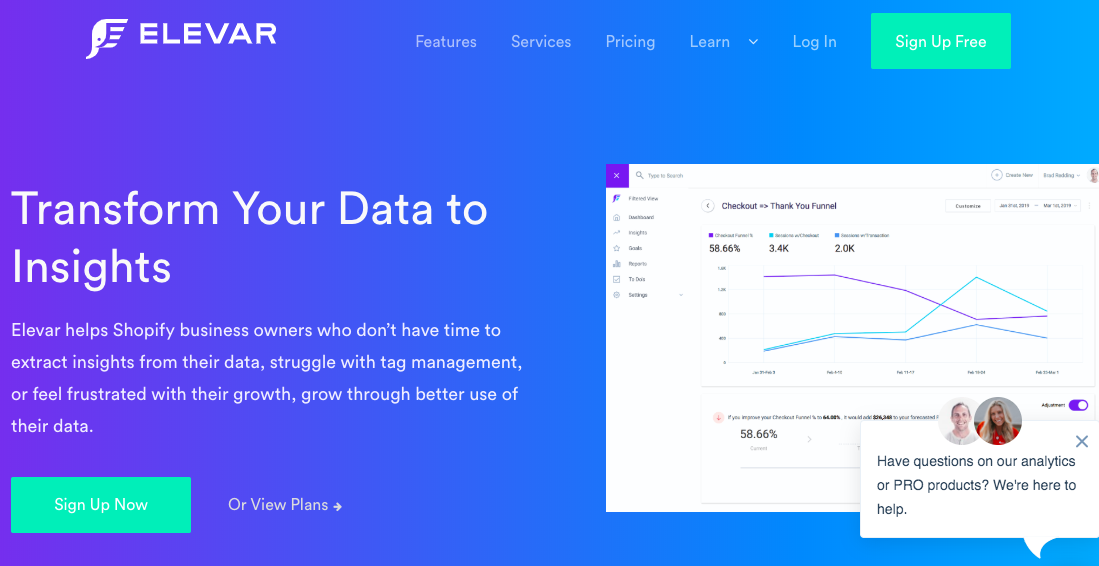
We shared with their team that in our experience, we’ve seen a question often works better than a declarative statement for above-the-fold copy on a home page. So we asked them, “What might be a question that we could ask prospects that speaks to something they want or are frustrated by?”
And the team began brainstorming, pulling ideas from the current headline and the description below:
- “Do you want help transforming your data into insights?”
- “Are you feeling frustrated with your growth?”
- “Are you spending too much time extracting insights from your data?”
As we mentioned earlier in the section on expectations, the key to effective brainstorming is creating an atmosphere where there are no wrong answers — and their team did great at coming up with ideas.
Next, we described to them that the function of a headline is to give you permission to ask more of the user by getting them to scroll or click a CTA. And we find that the most effective way to achieve this is by speaking to something that a prospect is experiencing now. Urgency creates tension that leads to forward motion. So we came up with a few more questions:
- “Can you really trust your data?”
- “Worried that you’re making decisions off data you can’t trust?”
Ideas during a workshop are off the cuff and in rough draft form. But in the case of this workshop, we ended up landing on a question that both of us liked. And today, Elevar’s home page reads:
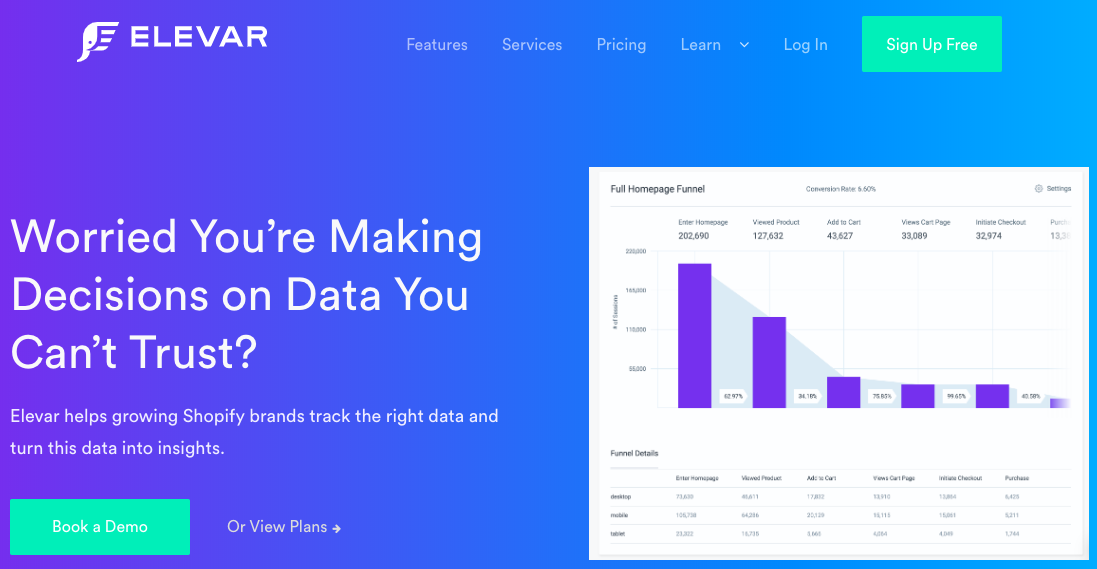
Whether or not you decide to make changes based on what was brainstormed, learning to get in the mindset of thinking like your customer and viewing your content through their eyes is a valuable experience on its own.
Now let’s look at the other bottleneck: structure.
Content Structure: Removing Friction from Your SaaS Website
For visitors who are in the market and ready to buy, we want to figure out, “How can we make this process as frictionless as possible for them?”
To use a traffic light metaphor, where are the yellow lights and red lights that slow and stop these in-market prospects from signing up? And how can we turn them into green lights?
Here’s a simple example of a discovery we made in a recent workshop. BoardOnTrack offers a school board management platform for charter schools.
Workshop Example #2: Applying Landing Page Practices to BoardOnTrack’s Home Page
Toward the beginning of a recent workshop with our client BoardOnTrack, we were analyzing their home page as a group. In particular we were looking at the content above the fold:
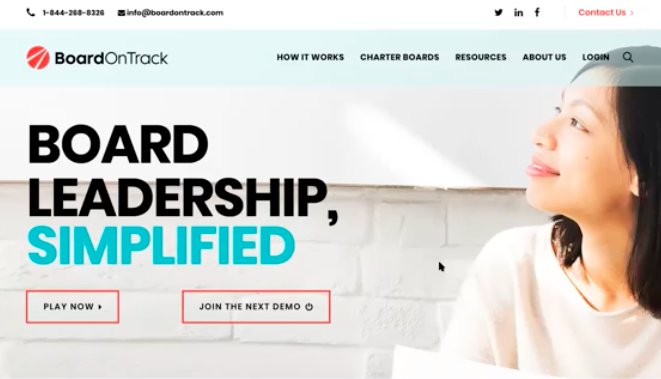
We asked their team, “What is the primary action or actions you want a site visitor to take on this page?”
The team agreed it was to play the video or click to sign up for a demo.
And then, starting in the top left corner of the page and reading from left to right, we counted how many links a user could click above the fold:
- Phone number
- Social channels
- Contact us
- How it works
- Charter boards
- Resources
- About us
- Login
- Search
- Play now
- Join the next demo
Seeing “Play Now” and “Join the Next Demo” sitting at #11 and #12 led into a discussion about how we could direct more focus towards those two desired actions. We asked, “How can we reduce the number of clickable links above the fold?”
Then, by viewing the page through the lens of Oli Garner’s attention ratio principle (covered in our article on SaaS landing pages), we decided to remove the first four links from the top bar and place the rest of the links behind a drop down menu.
What was left was a homepage with three places to click and two desired actions:
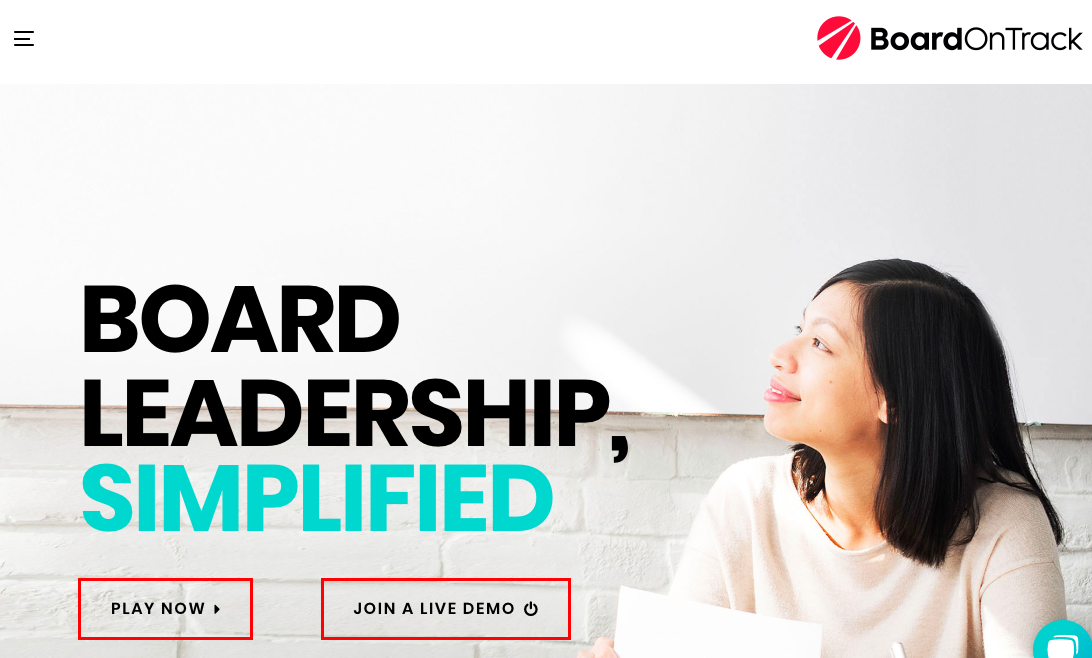
This is an example of how we might work on the structure of your content in the workshop.
Now let’s look at the second workshop from our SaaS pilot program, which usually happens about a week later.
Journey-Offer Fit Workshop: Co-Creating a Lead Magnet
For the large majority of website visitors who are not yet ready to buy, we want to make sure they have a way to engage with you without having to get on a sales call.
To achieve this, we work with you to create a lead magnet with relevant, useful content that helps you connect with your prospects, earn some trust, and begin educating them about the problem your product solves and the solution(s) you offer.
The types of lead magnets we create depend on our client and their business context. Here’s an example of an exercise we did to develop a self-assessment lead magnet. We called it “The IOT Velocity Quadrant.”
Workshop Example #3: Building a Self-Assessment Lead Magnet
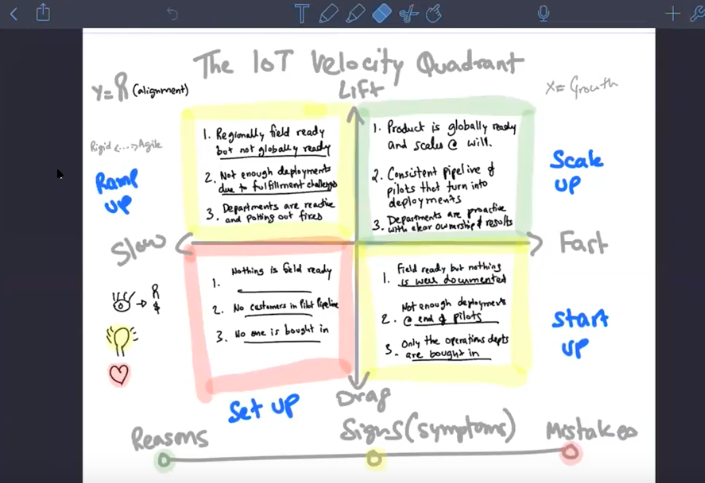
This was created with a client in the IOT space that makes globally deployable sim cards for hardware manufacturers that want global connectivity for their devices without having to deal with different telecoms providers in every country.
We chose to make a “self-assessment” lead magnet because it gives your prospect an opportunity to determine for themselves the extent to which they are experiencing a problem that your product solves. And it also helps them see where they are in relation to where they could be (Think: moving from a yellow quadrant to a green one with the help of your solution).
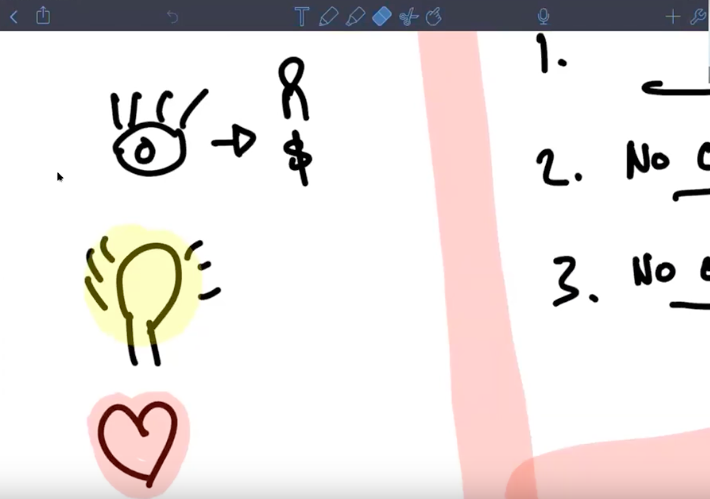
To build this out, we asked our client to describe what their customers are seeing, thinking, and feeling when they’re in each of these quadrants. We created this matrix together live inside the workshop, and then used it to make a polished version for the actual lead magnet.
In addition to the benefit of helping prospects gain a deeper understanding of the problem they’re experiencing, self-assessments also allow for a seamless transition from marketing to sales. For example, when you end up on a sales call with a prospect who filled out the assessment, you can ask them about where they landed in the matrix.
Both you and your prospects have a clearer understanding of where they’re at. And you might even have a different line of questions prepared for prospects who fall into different quadrants.
Before we wrap up here, let’s look at one last example of another lead magnet we created during a workshop.
Workshop Example #4: Building a Customer Pain Point Lead Magnet for Restaurant Systems Pro
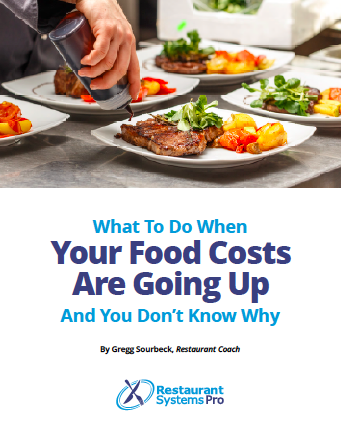
Restaurant Systems Pro offers a software service for restaurant owners to manage their restaurants more efficiently so they can improve their profit margins.
To decide which topic to focus on for their lead magnet, we went around the room and had their team share about the biggest pain points their customers were experiencing. The pain point that they agreed came up the most in conversations with prospects was rising food costs.
So we decided to focus on food costs, and we called the lead magnet, “What To Do When Your Food Costs Are Going Up And You Don’t Know Why.” The reason a title like this is effective is because it speaks to a key fear and frustration for their customers — the very frustration our client helped solve with their SaaS.
And then we moved into working on the body of the lead magnet, where we came up with 10 questions that restaurant owners should ask themselves when they’re experiencing this problem.
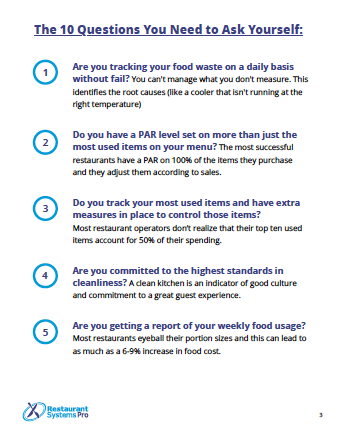
Each question followed a specific formula that we have found works well to create a self assessment that resonates:
- A ‘yes’ or ‘no’ question, so that answers are definitive.
- Followed by a declarative statement that is likely to resonate with the target user.
- And completed with an example of something that’s happening in their business (a relatable circumstance that only an industry insider would know).
To come up with the questions, we asked their team, “What are some of the questions you ask prospects during sales conversations?” As we went around the room, we listed questions and then brainstormed declarative statements and examples related to those questions.
The end result was a nearly finished lead magnet that, after some revision and design tweaks, we would offer to their prospects who were higher in the funnel through our ad channel testing.
Conclusion
We have a saying at Powered By Search: “Your magic, but in our model.”
We’re not trying to be smarter than you or pretend to know and understand your business better than you. We see our role as providing you with a framework and a process that helps draw out the magic of what you do and communicate it more effectively to customers.
We hope these examples have given you a clear sense of the types of collaborative exercises we do and the tangible assets that come out of our live workshops.
If this type of collaborative approach and relationship appeals to you, and you think you stand to benefit from experiences like the ones described above, schedule a Free SaaS Scale session to learn more about our SaaS Pilot Program.
What you should do now
Whenever you’re ready…here are 4 ways we can help you grow your B2B software or technology business:
- Claim your Free Marketing Plan. If you’d like to work with us to turn your website into your best demo and trial acquisition platform, claim your FREE Marketing Plan. One of our growth experts will understand your current demand generation situation, and then suggest practical digital marketing strategies to hit your pipeline targets with certainty and predictability.
- If you’d like to learn the exact demand strategies we use for free, go to our blog or visit our resources section, where you can download guides, calculators, and templates we use for our most successful clients.
- If you’d like to work with other experts on our team or learn why we have off the charts team member satisfaction score, then see our Careers page.
- If you know another marketer who’d enjoy reading this page, share it with them via email, Linkedin, Twitter, or Facebook.